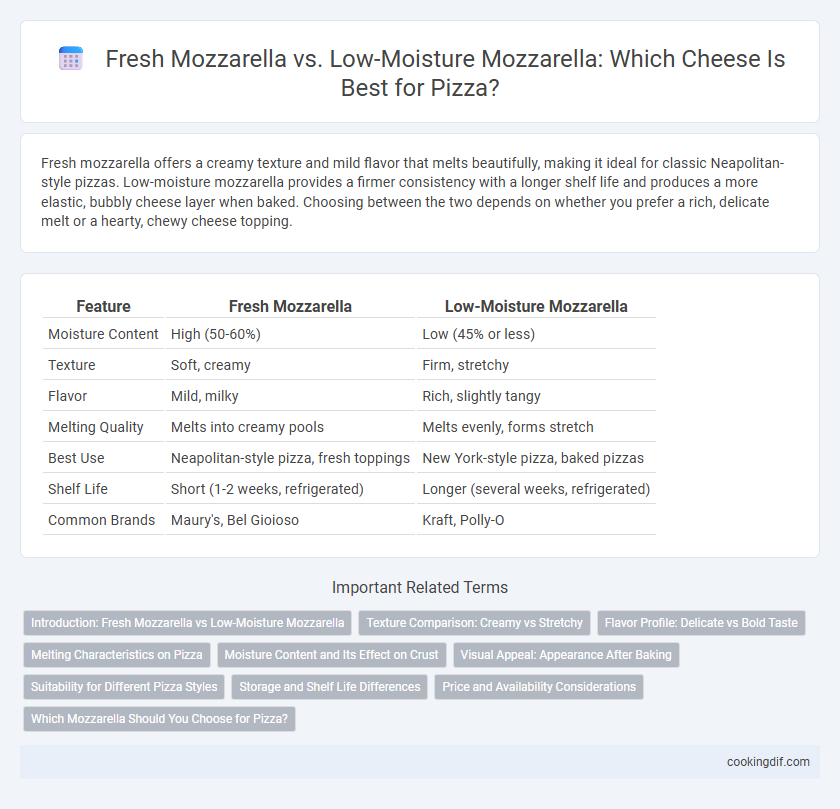Fresh mozzarella offers a creamy texture and mild flavor that melts beautifully, making it ideal for classic Neapolitan-style pizzas. Low-moisture mozzarella provides a firmer consistency with a longer shelf life and produces a more elastic, bubbly cheese layer when baked. Choosing between the two depends on whether you prefer a rich, delicate melt or a hearty, chewy cheese topping.
Table of Comparison
| Feature | Fresh Mozzarella | Low-Moisture Mozzarella |
|---|---|---|
| Moisture Content | High (50-60%) | Low (45% or less) |
| Texture | Soft, creamy | Firm, stretchy |
| Flavor | Mild, milky | Rich, slightly tangy |
| Melting Quality | Melts into creamy pools | Melts evenly, forms stretch |
| Best Use | Neapolitan-style pizza, fresh toppings | New York-style pizza, baked pizzas |
| Shelf Life | Short (1-2 weeks, refrigerated) | Longer (several weeks, refrigerated) |
| Common Brands | Maury's, Bel Gioioso | Kraft, Polly-O |
Introduction: Fresh Mozzarella vs Low-Moisture Mozzarella
Fresh mozzarella, known for its high moisture content and delicate, milky flavor, melts smoothly and creates a creamy texture ideal for traditional Neapolitan-style pizzas. Low-moisture mozzarella offers a firmer texture with a longer shelf life, delivering a more concentrated taste and a golden, bubbly crust preferred in New York-style and other American pizzas. Understanding the moisture levels and flavor profiles helps pizza makers select the perfect cheese to complement different crusts and toppings.
Texture Comparison: Creamy vs Stretchy
Fresh mozzarella offers a creamy, soft texture that melts smoothly, providing a rich and moist bite ideal for Neapolitan-style pizzas. Low-moisture mozzarella provides a stretchy, elastic texture with less moisture, creating the classic cheese pull preferred on New York-style pizzas. The choice between creamy and stretchy textures directly influences melt quality, moisture release, and overall pizza mouthfeel.
Flavor Profile: Delicate vs Bold Taste
Fresh mozzarella offers a delicate, milky flavor with a soft, creamy texture that melts smoothly on pizza, enhancing the natural sweetness of the dough and toppings. Low-moisture mozzarella delivers a bold, tangy taste with a firmer, drier consistency that creates a satisfying chew and a well-defined cheese flavor. Choosing between fresh and low-moisture mozzarella depends on whether you prefer subtle creaminess or pronounced cheesiness in your pizza experience.
Melting Characteristics on Pizza
Fresh mozzarella offers a creamy texture and melts smoothly, creating a gooey, tender layer that retains moisture on pizza. Low-moisture mozzarella has less water content, resulting in better browning and a stretchier, elastic melt ideal for classic pizza styles. The choice depends on desired texture: fresh mozzarella yields a rich, soft melt, while low-moisture delivers a reliable, slightly firmer cheese pull and golden finish.
Moisture Content and Its Effect on Crust
Fresh mozzarella, with its high moisture content of around 50-60%, creates a creamy texture but can release excess water during baking, leading to a soggy pizza crust. Low-moisture mozzarella typically contains 45-52% moisture, providing a firmer cheese that melts evenly without overly wetting the dough, resulting in a crispier crust. Choosing between fresh and low-moisture mozzarella significantly affects the pizza's texture, balancing cheesy creaminess against crust crunchiness.
Visual Appeal: Appearance After Baking
Fresh mozzarella melts into a creamy, bubbly layer with a bright white color and slightly uneven texture, creating an artisanal look on pizza. Low-moisture mozzarella browns more uniformly and develops a golden, slightly crispy exterior, enhancing the pizza's visual appeal with a classic, appetizing finish. The choice between them affects how the cheese visually complements the crust and toppings after baking.
Suitability for Different Pizza Styles
Fresh mozzarella, with its high moisture content and creamy texture, is ideal for Neapolitan and Margherita pizzas, providing a soft melt and a rich, milky flavor that complements thin, wood-fired crusts. Low-moisture mozzarella offers a firmer texture and longer shelf life, making it suitable for New York-style and deep-dish pizzas where a stretchier, evenly melted cheese with less water release is preferred. Choosing between these two types depends on the desired pizza style, melt quality, and moisture tolerance of the dough.
Storage and Shelf Life Differences
Fresh mozzarella contains higher moisture levels, requiring refrigeration and typically lasting 5 to 7 days when stored properly in brine or airtight containers. Low-moisture mozzarella, with reduced water content, can be stored longer--usually up to 6 weeks unopened in the refrigerator--and is more shelf-stable once shredded and frozen. Proper storage significantly impacts cheese texture and safety, with fresh mozzarella's short shelf life limiting its use to immediate consumption, while low-moisture varieties support extended storage and versatile pizza applications.
Price and Availability Considerations
Fresh mozzarella is typically more expensive and less widely available than low-moisture mozzarella due to its shorter shelf life and need for refrigerated storage. Low-moisture mozzarella offers greater affordability and longer shelf stability, making it a preferred choice for pizzerias requiring consistent supply and cost efficiency. Pricing fluctuations often depend on regional availability and production scale, influencing cheese selection in commercial pizza operations.
Which Mozzarella Should You Choose for Pizza?
Fresh mozzarella offers a creamy texture and mild flavor that melts beautifully, making it ideal for Neapolitan-style or artisan pizzas. Low-moisture mozzarella provides a firmer texture and better stretch with a longer shelf life, perfect for classic American-style pizzas requiring even melting and less water release. Choosing between fresh and low-moisture mozzarella depends on your desired pizza style, melt quality, and moisture control.
Fresh mozzarella vs Low-moisture mozzarella for cheese Infographic

 cookingdif.com
cookingdif.com